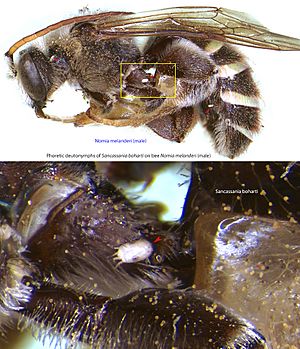Alkali bee facts for kids
Quick facts for kids Alkali bee |
|
|---|---|
 |
|
| Male bee. The lower frame is a blow-up of the small rectangle in the upper frame, showing a Zodion obliquefasciatum parasitizing him. | |
| Scientific classification | |
| Genus: |
Nomia
|
| Species: |
melanderi
|
The alkali bee, known scientifically as Nomia melanderi, is a special type of bee that lives in the ground. You can find these bees in the deserts and dry areas of the western United States. A scientist named Theodore Dru Alison Cockerell first described this bee in 1906.
Contents
The Amazing Alkali Bee
Home Sweet Salty Home
These bees build their nests in soil that has a lot of salt. This kind of soil is also called alkaline soil. They are known as "ground-nesting bees" because they dig tunnels and chambers underground. Each female alkali bee has her own nest. They live close to other female alkali bees, but each one works alone.
Helping Farmers
Alkali bees are very good at pollinating a plant called alfalfa. Alfalfa is an important crop used to feed farm animals. Like some other bees, alkali bees help alfalfa plants grow by moving pollen from one flower to another.
How They Pollinate Alfalfa
Alfalfa flowers have a special part called a "keel." The keel needs to be opened for pollination to happen. Alkali bees have a unique way of doing this. They press on the keel, which makes it snap open. This action helps the flower release its pollen.
Farmers and Bees Working Together
Farmers learned that if they plowed up the natural salty areas where these bees nested, their alfalfa crops would not grow as well. So, farmers started creating special salty mud-fields for the bees. These fields give the bees a safe place to dig their burrows and lay their eggs. This way, the bees can continue to help pollinate the alfalfa.
Who Preys on Alkali Bees?
The alkali bee can be hunted by a type of fly called the conopid fly. One specific type is Zodion obliquefasciatum. This fly can be a predator for the alkali bee.
See also
 In Spanish: Abeja de la alfalfa para niños
In Spanish: Abeja de la alfalfa para niños

